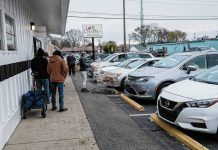When the Bartholomew County Plan Commission begins discussing proposed zoning amendments regarding solar energy systems, they will already have six pages of already-prepared proposals to consider.
Only commission members will be allowed to discuss proposals during the 8:30 a.m. meeting June 8, in the large first floor meeting room at Columbus City Hall.
A public hearing on ordinance changes under consideration will allow the public to speak at the same time and place on July 13.
The proposed amendments are from primary and secondary data generated by local planners, said Bartholomew County Commissioners Chairman Carl Lienhoop.
Columbus/Bartholomew County Planning Director Jeff Bergman, along with an assistant planner, received their primary data from visiting the Bluff Point Wind Energy Center, a $200 million investment launched in Jay and Randolph counties in late 2017.
The facility boasts it generates enough clean energy to power 35,700 households. But Lienhoop said he wanted Bergman to find out first-hand if the large solar field also generates excessive noise and other nuisances.
“They also secured zoning regulations from as many as four different counties and tried to marry the best out of them,” Lienhoop said. “That’s the basis of what they put together.”
For the past two years, Lienhoop and the other two commissioners have joined with a majority of Indiana counties to oppose state lawmakers establish rules and regulations. For the past two years in the Indiana General Assembly, efforts to create standardized commercial solar energy regulations for all 92 counties has failed.
But earlier this year, state lawmakers approved Senate Bill 411, which allows communities to voluntarily adopt regulations that will qualify them as a wind- or solar-ready community, with the hope that these standards will significantly cut project development time, lower costs and create thousands of jobs in the clean energy industries.
The reason why Lienhoop and the other two commissioners want local control is to mainly protect the county’s right-of-ways along local roads.
“We also wanted to provide a buffer for the people for the people who are going to be living next to these solar farms,” Lienhoop said. “We thought it would be better if we came up with a distance, rather than counting on the state to do it.”
However, Lienhoop stressed he doesn’t know if the commissioners are interested in having the final say on where commercial solar fields can be established.
Some of the key proposed regulations to be discussed are:
- All structures, equipment, storage areas and fencing, along with the solar panels, to be set back a minimum of 50 feet from the actual or planned right-of-way next to the nearest street or road.
- For rear yard setbacks, the distance must be a minimum of 30 feet from all side and rear property lines.
- No CSES facility shall be located closer than half-a-mile to any municipal boundary line.
- No electrical substation for a solar farm will be located within 750 feet of residential properties, while the minimum distance for related components shall be within 500 feet.
All items approved by the planning commission will be presented as recommendations to the county commissioners. At this time, no company or individual has filed a specific proposal for a commercial solar energy field. However, applicants will have to file for a variance from the Bartholomew Count Board of Zoning Appeals, which must also conduct a public meeting on the specific application.





